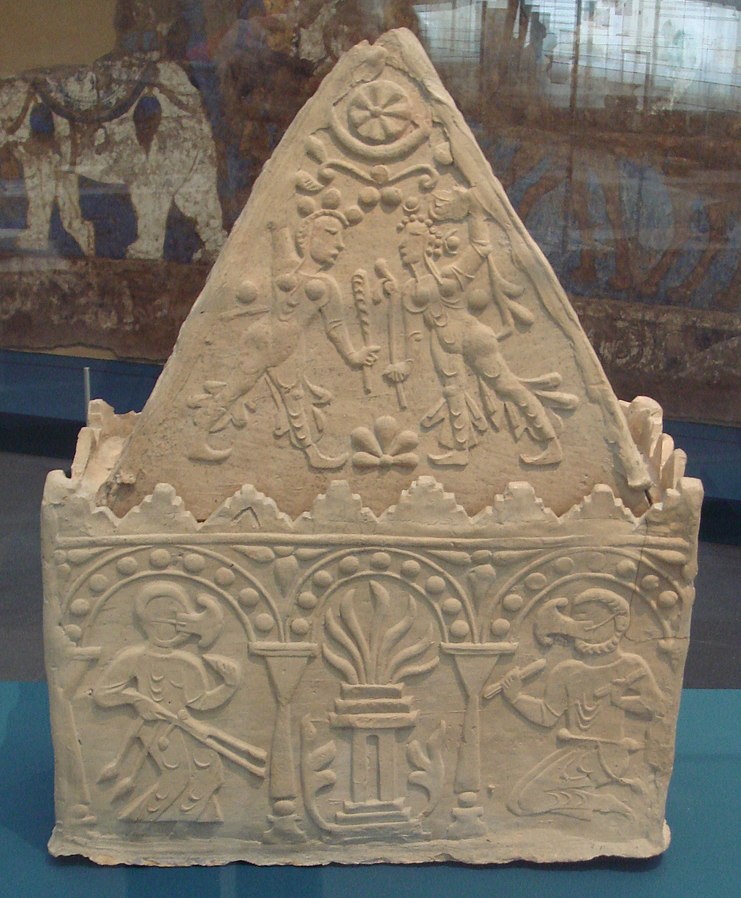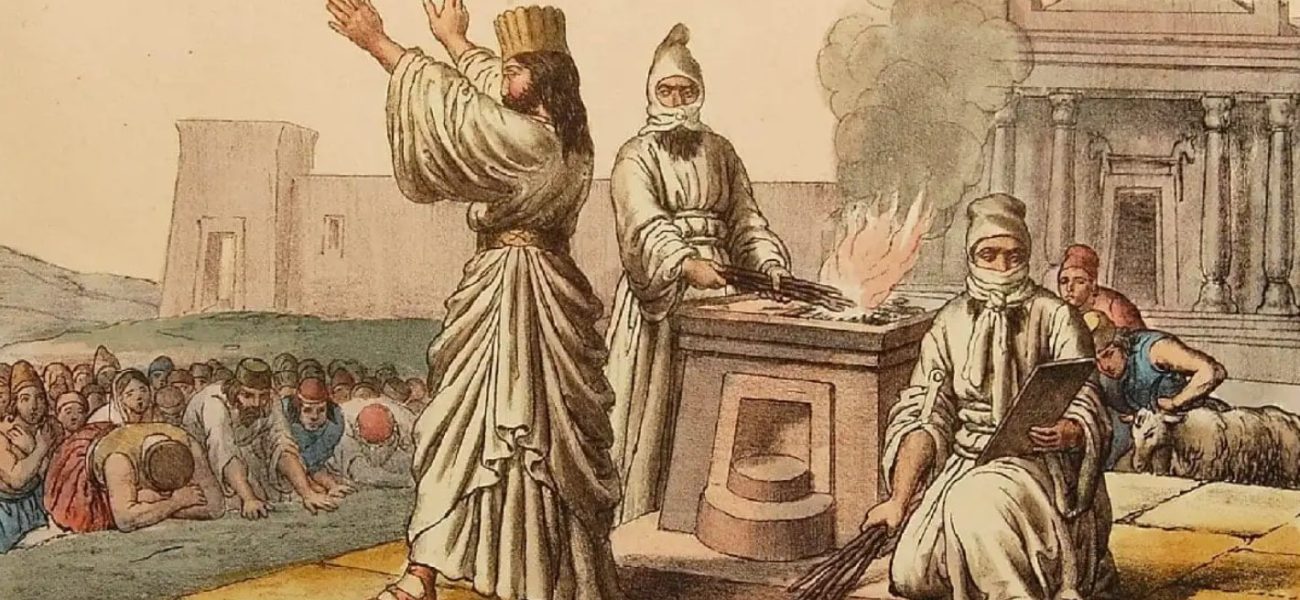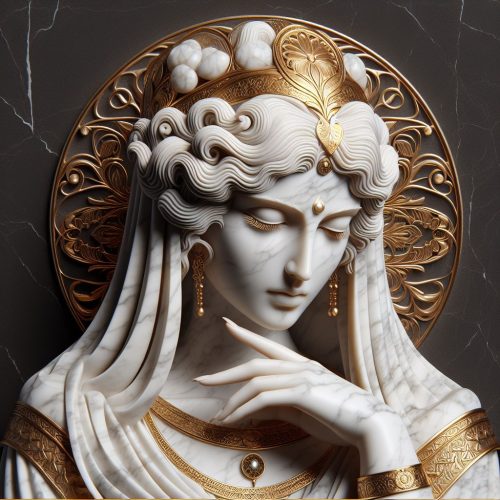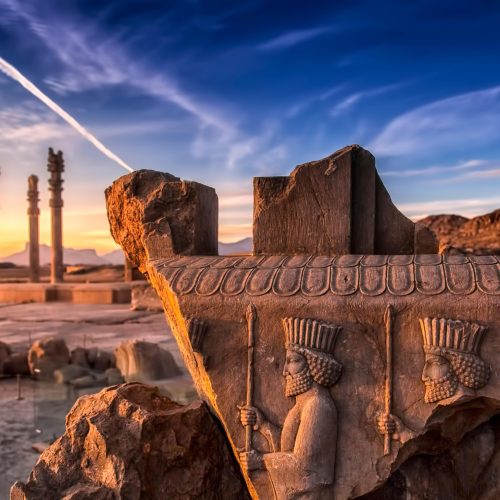Zoroastrianism, a venerable Iranian religion with roots stretching back millennia, stands as a testament to the enduring spiritual legacy of the ancient Persian civilization. Known as Mazdayasna in its native tongue and colloquially referred to as Behdin, Zoroastrianism has played a pivotal role in shaping not only the religious landscape of Iran but has also left an indelible mark on the broader tapestry of world religions.
Historical Foundations
Zarathustra’s Revelation
Zarathustra, also known as Zoroaster, emerges as a pivotal figure in the historical narrative of Zoroastrianism. His revelations, as chronicled in the Gathas, reflect not only a divine encounter but a profound philosophical exploration. Zarathustra’s spiritual journey culminated on the sacred slopes of Mount Hira, where he received divine insights that would shape the spiritual trajectory of ancient Iran.
The Gathas, composed in a poetic and enigmatic style, are a collection of hymns attributed to Zarathustra. They encapsulate his conversations with Ahura Mazda and serve as a guide for followers on the path of righteousness. These hymns delve into existential questions, the nature of good and evil, and the cosmic order, offering a glimpse into the philosophical depth of Zarathustra’s teachings.
Dualistic Cosmology
Central to Zoroastrianism is the concept of cosmic dualism, a distinctive feature that differentiates it from many other ancient belief systems. The eternal struggle between Ahura Mazda, the supreme and benevolent deity, and Angra Mainyu, the destructive force, forms the foundational framework of Zoroastrian cosmology.
Angra Mainyu, often identified as Ahriman, embodies chaos, deceit, and discord, seeking to undermine the divine order established by Ahura Mazda. This cosmic duality extends beyond the divine realm to influence the moral and ethical choices of individuals. Zoroastrianism thus presents a dynamic worldview where humanity is intricately entwined in the ongoing cosmic struggle between good and evil.
Spread and Evolution
Zoroastrianism flourished as the dominant religion in ancient Persia, with its influence extending to neighboring regions. The Achaemenid Empire, under Cyrus the Great, embraced Zoroastrian principles, fostering a climate of religious tolerance. However, the religion underwent significant transformations during the successive empires, including the Parthians and Sassanians.
The Arab conquests marked a critical juncture in the history of Zoroastrianism. While the religion faced challenges, including periods of persecution, the vibrant Zoroastrian communities persevered. Some sought refuge in the Indian subcontinent, where they came to be known as Parsis, contributing to the diverse cultural landscape of the Indian subcontinent.
Influence on Persian Culture
Zoroastrianism’s profound impact extends beyond religious practices to shape the cultural ethos of ancient Persia. The emphasis on truth, justice, and the eternal struggle between good and evil finds expression in Persian literature, art, and governance. The Avesta, the sacred scripture of Zoroastrianism, served as a source of inspiration for poets, philosophers, and rulers, leaving an indelible mark on the cultural heritage of the Persian people.
Preservation of Texts
The preservation of Zoroastrian texts, particularly the Avesta, has been a testament to the commitment of the community to safeguard its sacred knowledge. The Avesta comprises hymns, liturgical texts, and philosophical treatises. The meticulous oral transmission of these texts and their eventual transcription ensured the continuity of Zoroastrian wisdom through centuries.
Decline and Contemporary Challenges
Despite its historical resilience, Zoroastrianism faced challenges over the centuries, including the decline of Zoroastrian communities in its native land. The assimilative pressures of major religious shifts, notably the spread of Islam, led to a diminishing Zoroastrian population in Iran. However, communities in India, particularly the Parsis, continued to uphold and preserve their religious traditions.
In the contemporary era, Zoroastrianism grapples with challenges such as dwindling population numbers, interfaith dynamics, and the need to adapt to the changing socio-cultural landscape. Yet, the community’s commitment to preserving its ancient wisdom and engaging in interfaith dialogue underscores its ongoing significance in the broader religious tapestry.
Core Tenets and Practices
Zoroastrianism, with its rich tapestry of beliefs and rituals, encompasses a set of core tenets and practices that guide the lives of its adherents. Rooted in the teachings of Zarathustra and the sacred scriptures of the Avesta, these principles form the bedrock of the Zoroastrian faith.

Monotheism and the Immortals
Ahura Mazda:
At the heart of Zoroastrian belief lies the unwavering devotion to Ahura Mazda, the supreme and benevolent deity. Ahura Mazda is the creator of all that is good and represents the embodiment of divine wisdom, truth, and order. Zoroastrians engage in acts of worship, prayer, and meditation to strengthen their connection with Ahura Mazda, seeking guidance and enlightenment in their daily lives.
Divine Assembly:
Surrounding Ahura Mazda is a divine assembly of Yazatas and lesser deities, each tasked with specific responsibilities in maintaining the cosmic harmony. These entities, revered as divine beings, contribute to the multifaceted nature of the Zoroastrian spiritual realm. While Ahura Mazda reigns supreme, the divine assembly reflects the interconnectedness and interdependence within the divine hierarchy.
Fire Worship
Symbolism of Fire:
Fire occupies a central role in Zoroastrian rituals, symbolizing the divine light and purity associated with Ahura Mazda. Fire temples, where the sacred flame is perpetually kindled, serve as sacred spaces for communal worship. The act of tending to the sacred fire is a reflection of the Zoroastrian commitment to nurturing the divine presence and maintaining spiritual purity.
Rituals Involving Fire:
Zoroastrian rituals often involve the careful management and veneration of fire. The Yasna, a principal Zoroastrian liturgical service, includes the consecration of offerings in the presence of the sacred fire. The Gahambars, seasonal festivals in the Zoroastrian calendar, also feature communal rituals centered around the symbolic use of fire.
Moral Code – Asha

Asha and Cosmic Order:
Asha, the concept of cosmic order and truth, constitutes the moral and ethical foundation of Zoroastrianism. Adherents strive to align their lives with Asha, recognizing the interconnectedness between their actions and the broader cosmic balance. This principle underscores the importance of leading a life guided by honesty, integrity, and righteousness.
Virtues and Ethical Conduct:
Zoroastrian ethical principles emphasize virtues such as Vohu Manah (Good Mind), Asha Vahishta (Best Righteousness), and Spenta Armaiti (Holy Devotion). Followers are encouraged to embody these virtues in their interactions with others, fostering a sense of moral responsibility and compassion towards all living beings.
Purity and Rituals
Sudreh and Kusti:
Zoroastrians wear the Sudreh, a sacred undergarment, and the Kusti, a ritual belt, as symbols of their commitment to spiritual purity. The tying of the Kusti involves a series of ritual prayers, reinforcing the individual’s connection with Ahura Mazda and the divine principles of the faith.
Rituals and Celebrations:
Zoroastrian rituals extend beyond individual practices to communal celebrations. The Gahambars, marking various seasons, involve collective prayers, feasting, and acts of charity. Other ceremonies, such as the Navjote (initiation into the faith) and marriage rituals, highlight the significance of shared religious experiences within the Zoroastrian community.
In embodying these core tenets and engaging in ritual practices, Zoroastrians seek to forge a harmonious relationship with the divine, uphold moral virtues, and contribute to the cosmic order envisioned by Zarathustra. These practices, steeped in ancient wisdom, continue to guide the lives of Zoroastrians, fostering a sense of spiritual identity and interconnectedness with the eternal truths of Mazdayasna.
Zoroastrianism Beyond Iran

Diaspora Communities
Migration to India:
As Zoroastrianism faced challenges in its native land, particularly during the Arab conquests, a significant diaspora community emerged. One notable migration route led Zoroastrians to the Indian subcontinent, where they found refuge and established thriving communities. These Zoroastrians, known as Parsis, made significant contributions to Indian society while preserving their distinct religious identity.
Parsi Contributions:
Parsis played a pivotal role in various fields, including trade, industry, and education, contributing to the economic and cultural fabric of India. Their commitment to philanthropy resulted in the establishment of educational institutions, hospitals, and charitable organizations, leaving an indelible mark on the development of modern India.
Cultural Contributions
Persian Literature and Art:
Zoroastrianism’s influence on Persian culture transcends its religious practices and permeates various aspects of literature and art. Persian poets and thinkers drew inspiration from Zoroastrian themes, incorporating them into their works. The rich symbolism and ethical principles of Zoroastrianism found expression in Persian literature, contributing to the cultural identity of the region.
Governance and Legal Codes:
Zoroastrian principles also influenced governance and legal codes in ancient Persia. The concept of justice, as exemplified by the Zoroastrian emphasis on truth and righteousness, found reflection in the legal systems of Persian empires. This impact is evident in historical documents and inscriptions that reveal the fusion of Zoroastrian ethics with the administrative and legal structures of the time.
Preservation of Traditions
Ritual Adaptations:
Zoroastrian communities in the diaspora, while adapting to their new cultural contexts, have demonstrated resilience in preserving their religious traditions. The construction of fire temples, the continuation of rituals, and the maintenance of community ties have been essential in sustaining Zoroastrian identity outside Iran.
Interfaith Dialogue:
Engaging in interfaith dialogue has been a hallmark of Zoroastrian communities in diaspora. This dialogue fosters mutual understanding and appreciation for diverse religious traditions, contributing to a broader narrative of religious tolerance and coexistence.
Contemporary Challenges and Revival Efforts
Population Decline:
Zoroastrian communities, both in Iran and the diaspora, face the challenge of a declining population. Efforts to address this issue include awareness campaigns, community outreach, and initiatives to encourage the preservation of cultural and religious heritage among younger generations.
Cultural Revival:
Contemporary Zoroastrians are actively involved in cultural revival efforts. These initiatives encompass educational programs, publications, and digital platforms that aim to disseminate knowledge about Zoroastrianism. The goal is to ensure the continuity of the faith by fostering a sense of pride and connection to Zoroastrian heritage.
In navigating the challenges of a diasporic existence, Zoroastrian communities have not only preserved their ancient traditions but have also contributed significantly to the societies in which they reside. The story of Zoroastrianism beyond the borders of Iran is one of adaptation, resilience, and a continued commitment to the enduring principles laid out by Zarathustra in the ancient past.
Challenges and Revival

Historical Challenges
Arab Conquests and Persecution:
Zoroastrianism faced a critical period of challenge and change during the Arab conquests in the 7th century. The spread of Islam marked a transformative era for the region, leading to significant changes in religious dynamics. Zoroastrians encountered challenges to their religious practices, and some faced persecution. Despite these adversities, Zoroastrian communities exhibited resilience, adapting to new circumstances while holding onto essential aspects of their faith.
Decline of Zoroastrian Influence:
The decline of Zoroastrian influence in its native land was a multifaceted process influenced by political, social, and cultural shifts. While Zoroastrianism had once flourished as the dominant religion, the changing political landscape and the influence of new religious ideologies contributed to its diminished prominence in the regions it had once defined.
Contemporary Challenges
Dwindling Population:
One of the significant challenges faced by Zoroastrian communities, both in Iran and the diaspora, is the dwindling population. Factors contributing to this decline include a combination of lower birth rates, emigration, and interfaith marriages. The preservation of Zoroastrian identity becomes a crucial endeavor in the face of this demographic challenge.
Interfaith Dynamics:
Zoroastrian communities in contemporary society often find themselves in close proximity to diverse religious traditions. Interfaith dynamics bring both opportunities for dialogue and challenges of assimilation. Balancing the preservation of Zoroastrian identity with engagement in broader societal contexts requires thoughtful navigation of interfaith relationships.
Contemporary Revival Efforts
Educational Initiatives:
Efforts to revive and preserve Zoroastrianism include educational programs aimed at fostering a deeper understanding of the faith. These initiatives encompass religious education for younger generations, scholarly research, and the establishment of institutions dedicated to the study and propagation of Zoroastrian principles.
Community Outreach:
Zoroastrian communities actively engage in community outreach programs to connect with their members and raise awareness about the rich cultural and religious heritage of Zoroastrianism. This outreach includes events, seminars, and collaborations with educational institutions to share the tenets of the faith with a broader audience.
Interfaith Dialogue:
Participation in interfaith dialogue has become increasingly significant for Zoroastrian communities. Engaging with members of other religious traditions fosters mutual understanding, dispels misconceptions, and promotes a spirit of cooperation. This dialogue is essential in a globalized world where diverse religious communities coexist.
Digital Platforms and Media:
The use of digital platforms and media has emerged as a powerful tool in the contemporary revival of Zoroastrianism. Websites, social media, and online publications provide avenues for the dissemination of information, fostering a sense of community among Zoroastrians worldwide. These digital platforms also contribute to a broader dialogue on religion, culture, and identity.
In facing historical challenges and contemporary obstacles, Zoroastrian communities exhibit resilience through proactive measures aimed at preserving their ancient faith. The ongoing dialogue between tradition and adaptation forms a dynamic narrative of revival, ensuring that the flame of Zoroastrianism continues to burn brightly into the future.
Zoroastrianism and Interfaith Dialogue

Contributions to Ethical Thought
Shared Ethical Values:
Zoroastrianism’s ethical principles, rooted in the concept of cosmic order and truth (Asha), share common ground with many other major world religions. Engaging in interfaith dialogue allows Zoroastrians to highlight the universal values they cherish, such as honesty, justice, and compassion. This recognition of shared ethical foundations forms the basis for meaningful conversations with members of diverse religious traditions.
Intersecting Virtues:
Exploring the intersections of virtues like Vohu Manah (Good Mind), Asha Vahishta (Best Righteousness), and Spenta Armaiti (Holy Devotion) within the broader ethical landscape fosters a deeper understanding of the common aspirations that unite people across religious boundaries. Interfaith dialogue becomes a platform for discovering the resonance of Zoroastrian virtues in the ethical frameworks of other faiths.
Environmental Stewardship
Zoroastrianism and Nature:
Zoroastrianism’s reverence for nature and the elements aligns with contemporary concerns for environmental stewardship. The recognition of the divine presence in the natural world, manifested in rituals involving fire and water, can serve as a bridge in interfaith discussions about the spiritual dimensions of environmental responsibility.
Collaborative Efforts:
Interfaith dialogue provides a space for Zoroastrians to collaborate with members of other faith communities on shared environmental initiatives. The emphasis on protecting the Earth as a divine creation aligns with global efforts for sustainable practices, making Zoroastrianism a potential ally in interfaith environmental movements.
Bridging Historical Understanding
Historical Contributions:
Zoroastrianism, as one of the world’s oldest monotheistic religions, has made historical contributions to the development of religious thought. Engaging in interfaith dialogue allows Zoroastrians to share their unique perspectives on the historical evolution of religious concepts, contributing to a more comprehensive understanding of the shared heritage of humanity.
Dialogues on Tolerance:
The historical challenges faced by Zoroastrian communities, such as the Arab conquests, provide opportunities for dialogue on religious tolerance and the resilience of faith in the face of adversity. Sharing these historical narratives fosters empathy and mutual respect among participants in interfaith discussions.
Social Justice and Human Rights
Advocacy for Justice:
Zoroastrianism’s emphasis on justice as a fundamental principle aligns with the global pursuit of social justice and human rights. Participating in interfaith dialogue allows Zoroastrians to advocate for principles of fairness, equality, and ethical governance, contributing to broader discussions on societal well-being.
Collaborative Initiatives:
Zoroastrian communities, through interfaith platforms, can collaborate on initiatives addressing issues such as religious freedom, minority rights, and social equality. By standing in solidarity with other faith communities, Zoroastrians contribute to the collective efforts aimed at creating a more just and compassionate world.
Promoting Religious Tolerance
Dispelling Misconceptions:
Interfaith dialogue provides an opportunity for Zoroastrians to dispel misconceptions and promote a nuanced understanding of their beliefs. Open and respectful discussions can bridge gaps in knowledge, fostering a climate of tolerance and appreciation for the diversity of religious expressions.
Building Bridges of Understanding:
Zoroastrian participation in interfaith dialogue contributes to the building of bridges between diverse religious communities. Through shared experiences, Zoroastrians and representatives of other faiths can develop a more profound understanding of each other’s beliefs, fostering a climate of respect and harmony.
In summary, Zoroastrianism’s engagement in interfaith dialogue serves not only to highlight its unique contributions to global ethical thought but also to build bridges of understanding, advocate for shared values, and collaboratively address pressing issues such as environmental stewardship, social justice, and human rights. By participating in these dialogues, Zoroastrians contribute to the broader narrative of global harmony and cooperation among diverse religious traditions.
Zoroastrianism, with its rich historical tapestry and enduring philosophical legacy, continues to captivate scholars, practitioners, and those engaged in interfaith dialogue. From the sacred hymns of Zarathustra to the flickering flames in Zoroastrian fire temples, the ancient wisdom of Mazdayasna remains a source of inspiration, fostering a deeper understanding of the profound spiritual heritage that emanates from the heart of Iran. As Zoroastrian communities navigate the challenges of the modern world, the enduring flame of their faith illuminates a path that transcends borders and invites all to explore the timeless teachings of this ancient Iranian religion.




